In an era where social media DMs and texting dominate, you might wonder why email still holds its ground. But do you know that 62.86% of business professionals prefer to communicate via email?
But again, the average open rate for emails is only 21.3%. So, how do you ensure your emails are not only opened but also read and acted upon?
In this guide, we are going to reveal 14 pro email writing tips for your business so that your customers receive, read, and return to contribute to your business ROI. Let’s dive in.
Importance of Effective Email Communication
Effective email communication is all about getting your message across clearly and respectfully. It’s like having a good conversation but through written words. Here is why effective email communication is important for your business:
Professionalism and Credibility
Well-written emails reflect professionalism and enhance your credibility. It indicates that you are detail-oriented, organized and respectful of your recipient’s time.
Relationship Building
Not every email is to sell something. You can educate and inform your readers. Such personalized and thoughtful emails help you build and maintain professional relationships.
Record Keeping
Emails serve as a written record of communications, agreements, and decisions. They help you maintain transparency and accountability, so if any dispute happens, you can utilize them.
14 Pro Email Writing Tips To Write An Effective Email
Whether you are writing an email to sell or nurturing the lead, the success of this campaign depends on the open rates. And open rates depend on how effectively you have crafted each component of the email. Here are 14 email writing tips that can take your email from basic to pro level and get the work done:
Know Your Audience
When you know who you are writing to, their role, their challenges, and what makes them tick- you’re not just sending an email. You’re starting a conversation that matters. You are showing you get them, you care, and you have some value to offer.
Let’s say you are writing to a CEO. They are already juggling between multiple things. By keeping the email short, you can get directly to the bottom line. For example, you could mention how your product could boost their profit by 20% this quarter.
But if you are writing to a tech whiz or an IT manager, you can add some tech jargon. For example, you can talk about how your software would cut their downtime in half and process data faster on a last-minute project.
See the difference? Same product, different approach. All because of different audiences!
So, before you jump start into writing-
- Step into your reader’s shoes.
- Understand what their pain points are.
- Figure out what you can do to make their day easier
A Click-Worthy Subject Line
Did you know that an average professional receives a whopping 120 new emails each day? In this email avalanche, it’s easy for your message to get deleted, ignored, or worse, banished to the spam folder. But then, how can you stand out? The answer lies in a catchy subject line!
Let’s look at these two examples
![]()
![]()
Grammarly’s subject line is a masterclass in effectiveness. Here’s why:
- Grammarly’s subject line clearly states what’s being offered. Without opening the email the readers can understand what they are getting. But the other one gives no hint about what they are “ interested” in.
- Grammarly’s subject line is short and fits entirely in the limited space. But the second subject line gets cut off, potentially causing them to lose crucial information.
- Grammarly maintains a professional tone while still being friendly with the emoji. But “ Hey, There…” may come across as unprofessional.
- Grammarly clearly states the benefits- better writing, and their offer – 50% off. But the other one doesn’t indicate any value for the recipient.
Now, with all these green flags, Grammarly is building trust. But the second one’s vague claim about the problems seems like a phishing attempt or spam.
Do Not Miss A Preheader
While Marketers spend hours perfecting the email subject line, they often forget the preheaders. However, according to a GetResponse survey, emails without preheaders lag with a 25.72% open rate and a mere 1.97% click-through rate. But what is a preheader?
The Preheader is the snippet you see right after the subject line. It gives the readers a sneak peek of the email content and can turn a hesitant recipient into an eager reader. If you don’t add a preheader, the first few lines of your email will appear here.
Let’s dissect this preheader-
![]()
- The preheader works as an extended subject line and gives you more space to entice the readers.
- The preheader is short yet provokes the readers to open up.
- This preheader provides additional information, and it shows what the readers will benefit from.
So, learning from this one?
- Keep your preheader short, ideally between 40-120 characters.
- Don’t repeat your email subject line. Rather, a preheader should compliment the subject line.
- With a preheader, you can give your readers a hint, create curiosity, or evoke FOMO ( fear of missing out).
- Use action words like- Read, Boost, Limited time offer, and Discover.
Start with Proper Greetings
You’ve nailed your subject line and preheader. The recipient has opened your email. Now what? How you greet them will build the foundation of the connection.
Greetings set the proper tone for your email. It also shows your professionalism and courtesy.
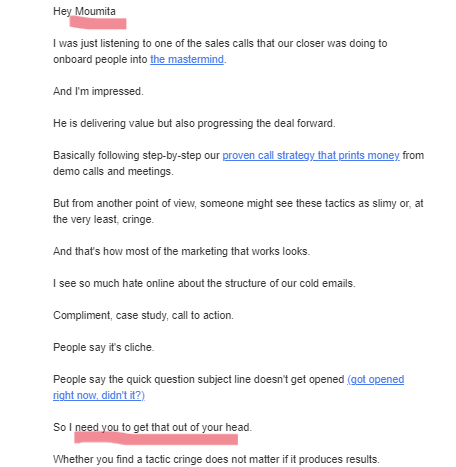
To craft the perfect greeting-
- Use the recipient’s name whenever possible to create a personalized touch.
- Match the greetings to your relationship: “Dear” for formal, “Hi” or “Hello” for more casual intention
- Not every professional likes to be overly casual. Avoid terms like “ Hey” and “yo”.
Check The Recipient’s Name Carefully
Have you ever received an email starting with “ Dear Brian” but you are actually “ Bryan”? Imagine how embarrassing it is for the sender!
When you address a recipient by their name, it makes the email more personalized. But if you use the wrong name or misspell it, it shows how negligent you are.
So here are some tips:
- Give the name a second look before sending
- Often, we autocomplete our writing. But sometimes it’s better to avoid it.
- Not everyone is a big fan of the middle name, so be careful. You can check their email signature or LinkedIn for that.
- Be mindful of the cultural difference in name order.
Keep One Message Per Email
When you cram multiple topics into one email, it’s like serving a pizza topped with ice cream and sushi. Sure, they are great on their own, but together? That’s a recipe for confusion! Similarly, mixing different messages in a single email can leave your readers bewildered and unsure where to focus.
With different sub-topics, readers are also left wondering which part to tackle first or what can wait, ultimately leading them to abandon your email altogether.
By sticking to one message per email, you provide your readers with an easy-to-follow roadmap. They immediately understand your purpose, why it matters, and what action to take next.
Let’s look at this email to understand it better.
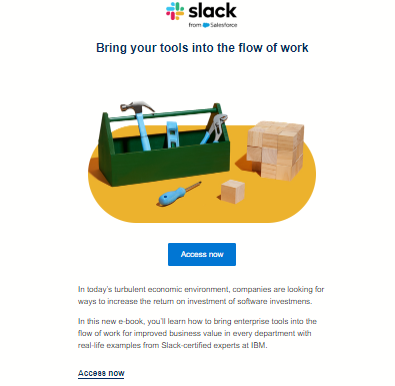
- The email solely focuses on bringing new tools for workflow improvement. There are no unrelated topics or features they tried to even touch.
- The concise text provides enough information to explain the value proposition without diluting the central message.
- The clear and repeated “Access Now” CTA directly relates to the email’s single focus, making it easier for readers to take their next action.
Keep Your Copy Concise
Brevity is the soul of wit—it’s the secret sauce of killer emails. Why? Because in this fast-paced digital world, your readers are way too busy to read a chunky piece of content. It’s that simple.
A short and simple email shows that you respect the reader’s time. It increases the chances of your email being read.
Let’s check out this email example
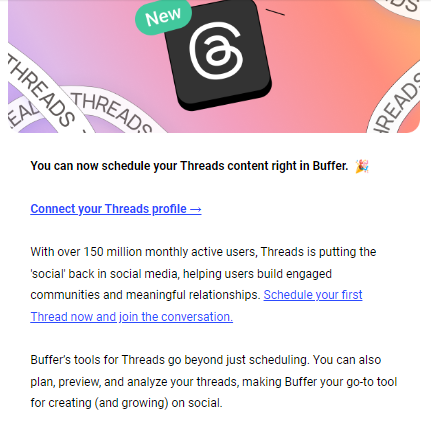
- The headline delivers the main message in one punchy sentence. Readers know it’s about the ‘’Thread’s scheduling’’ feature simply by looking at it.
- The key information stands out prominently as it is surrounded by less text.
- The email highlights the value proposition of this feature by mentioning how Threads helps to build an engaged community.
- The clear CTAs at the end are promoting immediate engagement.
Be Consistent with Voice and Tone
Imagine having a friend who constantly switches accents mid-conversation. Confusing right? That’s what inconsistent voice and tone in emails feel like to your readers.
Again, your email voice is your brand’s personality in writing. It reinforces your brand identity, prevents misinterpretation, and makes your emails authentic and trustworthy.
To nail a consistent voice and tone throughout your email:
- Start with defining your brand’s personality. Do you want to sound friendly and approachable or professional and authoritative? Your brand value should reflect your business’s values and resonate with your target audience.
- Create a style guide. In one document, add your brand-preferred language, common phrases, tone, and writing style.
- While your core value should be consistent, you might need to tweak it slightly for different audience segments. However, ensure you don’t lose the essence of your brand in the process.
Personalize Your Emails
Did you know that, according to a MessageGears Study, 83% of consumers prefer to receive a hyper-personalized marketing email? Personalization transforms your email from a generic message to a conversation. It indicates that you have taken some time to understand your readers.
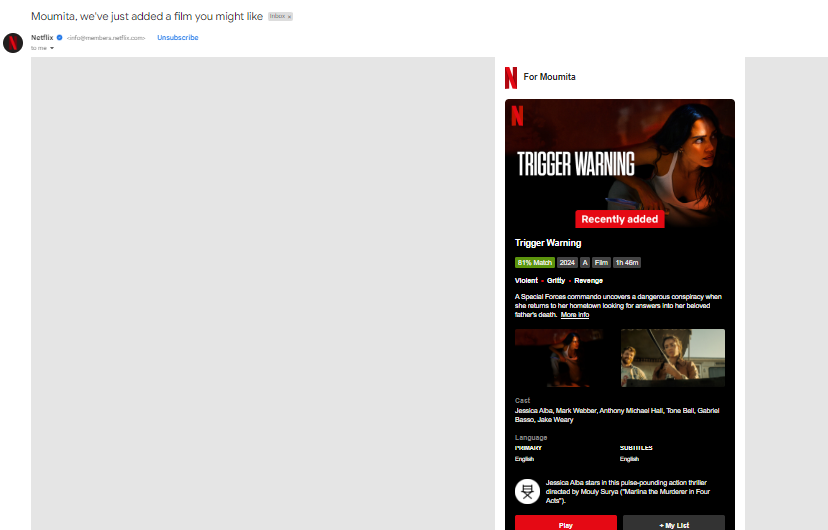
This email from Netflix is a great example of personalized email.
- They start personalization right from the bat- the subject line.
- They address the recipient by name and recommend a specific movie based on what they think Moumita might enjoy. It shows they’ve considered her viewing preferences.
Use CC/Bcc When Needed
CC and BCC are powerful tools that can enhance your email communication when used appropriately.
Use the CC field to include individuals who need to be informed about the email’s content but are not the primary recipients. This is particularly useful for keeping necessary stakeholders in the loop or for collaborative projects where transparency is key. However, avoid overusing CC, as it can lead to cluttered inboxes and information overload.
BCC is your go-to for protecting privacy in mass emails or when recipients shouldn’t see each other’s addresses. For making introductions, use BCC to connect people and then bow out gracefully, preventing a cluttered thread and maintaining privacy.
Focus on “ What’s in It for Them”
When writing an email, it’s tempting to shout about your offerings. But why should your readers care about that? It’s time to shift your focus.
Focus on the benefits. Show them how you are solving a problem, saving them time or money, or improving their life. Consequently, you will improve your email marketing ROI.
Let’s look at this email to turn your next email into a goldmine for your readers.
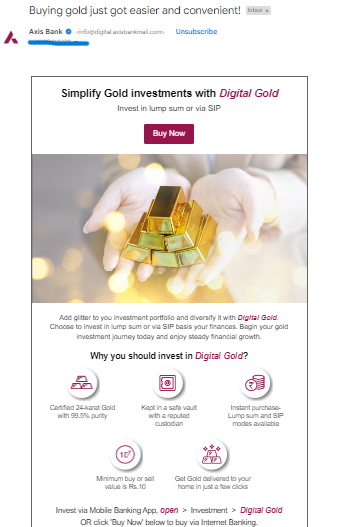
- The email begins with a clear, benefit-driven subject line and heading, capturing the reader’s attention immediately.
- Instead of listing their services, they frame them as customer benefits.
For example:
- “Certified 24-karat Gold” translates to quality assurance.
- “Add to SIP” highlights easy integration with existing investments.
- “Instant Liquidity” emphasizes quick access to funds when needed.
Add A Relevant CTA
A CTA gives your email a purpose. Think of it as the guiding hand to lead your readers toward the next step you want them to take.
Let’s check out this example-
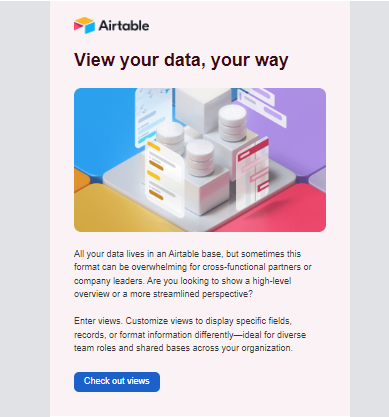
- The CTA button “ Check out views” is a direct instruction. It leaves no room for confusion for readers.
- The body of this content discusses customizing views to display data in an Airtable base, and the CTA invites users to explore the feature. The CTA is directly relevant to the email.
- The CTA button is prominently placed.
A Professional Signature
Your email signature is akin to a digital business card—it represents you and your business, adding a touch of professionalism while providing essential information. A well-crafted email signature not only leaves a lasting impression but also makes it easy for recipients to contact you and understand your role within the organization.

Key Elements of a Professional Signature:
- Full Name: Clearly state your full name to establish a personal connection.
- Job Title and Company: Include your job title and the name of your company to provide context and credibility.
- Contact Information: Provide your phone number, email address, and physical address (if relevant) to facilitate easy communication.
- Website and Social Media Links: To enhance your digital presence, add links to your company’s website and professional social media profiles.
- Company Logo: Including your company’s logo can reinforce brand identity and make your signature visually appealing.
- Legal Disclaimers (if necessary): Some industries require legal disclaimers or confidentiality notices; include these as needed.
You can use various tools like HubSpot Email Signature GeneraeffectivelyStamps and MySignature to create professional email signatures that align with your brand’s image.
Proofread Before Sending
Imagine sending an email to a potential lead filled with glaring typos or missing crucial details like the meeting time. Such mistakes can damage your credibility and hurt your business prospects.
Proofreading your email before sending it is a crucial step. It ensures clear, effective and error-free communication.
Tips to effectively proofread your email:
- After writing an email, take a break before proofreading. With fresh eyes and a clear mind, you can catch mistakes more easily.
- Use tools like Grammarly extension or your email client’s built-in spell checker to catch typos and grammar issues.
- Double-check the names, job titles, and company names to ensure accuracy.
- Ensure your email is well-formatted with proper bold and italics.
- Check if the links are working and direct to the correct URLs.
Conclusion
Email is pretty much the go-to for everything these days. Whether you are nurturing a lead or sending a cold email, email is your wingman. However, the widespread use of email marketing has led to a significant challenge: inbox overload.
With all this noise, getting noticed is like trying to be heard at a rock concert. People are getting really picky about what they open, so many emails end up in the spam folder. But no cookie-cutter messages or pushy sales pitches will cut it. You need to be more creative.
Implement the 14 email writing tips you learned today one by one in your next email. Analyze the results and boost your email ROI.
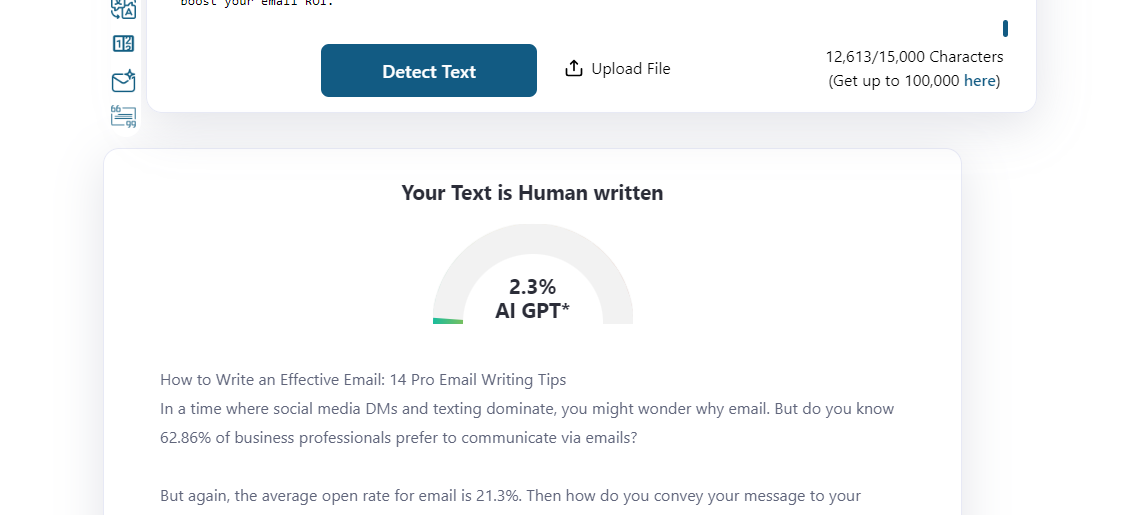
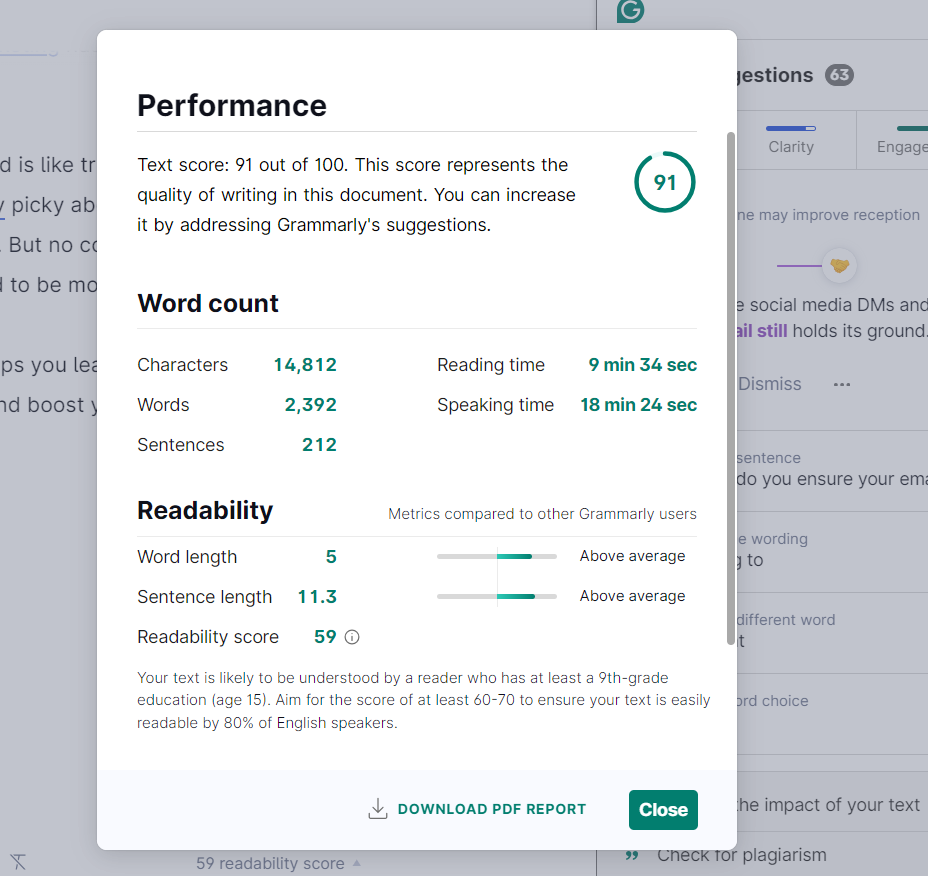
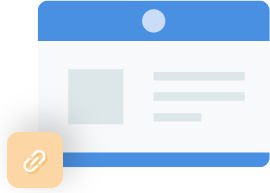
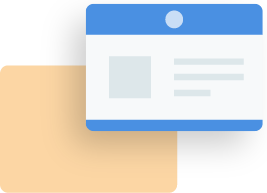
 info@cultbooking.com
info@cultbooking.com  0049 30 726225 0
0049 30 726225 0 